The global milk froth thermometer market is valued at USD 117.8 million in 2025 and is projected to reach USD 188.3 million by 2035, advancing at a CAGR of 4.8%. The market will generate an absolute dollar opportunity of USD 70.5 million during the forecast period. Based on decade-long performance consistency, the Growth Rate Volatility Index (GRVI) is assessed at 0.19, suggesting a low-volatility, steady-growth profile supported by expanding café culture, professional barista training programs, and rising consumer adoption of specialty coffee equipment.
Manufacturers are focusing on thermometers with enhanced precision, faster response times, and durable materials such as stainless steel and reinforced glass. Integration of clip-on and digital display features is becoming more common, improving usability in both commercial and household settings. Product development also emphasizes temperature accuracy within the optimal milk frothing range (55–65°C), which remains critical for consistent texture and taste in espresso-based beverages.
Europe and North America continue to lead in market consumption, driven by established coffee service industries and strong consumer preference for manual brewing accessories. Asia Pacific exhibits increasing adoption as café chains and artisanal beverage outlets expand regionally. Through 2035, innovation in sensor calibration, ergonomic design, and supply chain efficiency will sustain the market’s balanced, low-volatility growth trajectory.

Between 2025 and 2030, the milk froth thermometer market is projected to grow from USD 117.8 million to USD 149.0 million, representing an acceleration phase with a 26.5% increase during the first five years. This growth will be driven by rising global coffee consumption, the expansion of café culture, and the increasing focus on beverage quality consistency across both commercial and household segments. The adoption of digital and smart thermometers with faster response times and higher precision will further propel demand. Manufacturers are emphasizing user-friendly, durable, and food-grade materials to meet stringent safety and accuracy standards in the hospitality and food service industries.
From 2030 to 2035, the market is forecast to rise from USD 149.0 million to USD 188.3 million, marking a deceleration phase with a 26.3% increase as market growth stabilizes. During this phase, product adoption will reach maturity across developed economies, while incremental growth will stem from emerging café markets and small-scale food service operators. Innovation will center on smart connectivity, temperature calibration technologies, and energy-efficient sensor systems. Competitive differentiation will increasingly rely on design aesthetics, integration with automated frothing systems, and sustainability-driven product materials such as stainless steel and recyclable components.
| Metric | Value |
|---|---|
| Market Value (2025) | USD 117.8 million |
| Market Forecast Value (2035) | USD 188.3 million |
| Forecast CAGR (2025-2035) | 4.8% |
The milk froth thermometer market is growing as cafés, restaurants, and home baristas emphasize precise temperature control for consistent milk texturing in espresso-based beverages. These thermometers, typically analog or digital, ensure milk is heated within the optimal range between 55°C and 65°C to achieve stable foam density and prevent flavor degradation. Manufacturers design thermometers with fast-response probes, anti-fog dials, and clip-on attachments to enhance usability during high-volume service. The popularity of specialty coffee culture and professional brewing techniques drives steady adoption across both commercial and domestic environments, reinforcing product demand within the global beverage equipment ecosystem.
Growth is further supported by the expanding café franchise network and increasing consumer interest in at-home coffee preparation. Compact, stainless-steel models dominate due to their durability and ease of cleaning, while emerging digital variants incorporate auto-alerts and calibration features for improved accuracy. The integration of temperature-monitoring accessories within automated frothing systems represents an emerging trend among premium appliance manufacturers. Despite market maturity in developed regions, rising disposable income and café expansion in Asia-Pacific sustain sales momentum. Competitive differentiation relies on precision, build quality, and ergonomic design. Continuous innovation in sensor responsiveness and user-friendly calibration ensures long-term stability for the milk froth thermometer market.
The milk froth thermometer market is segmented by classification, application, and region. By classification, the market is divided into pointer type and digital type thermometers. Based on application, it is categorized into personal and commercial use. Regionally, the market is segmented into North America, Europe, East Asia, South Asia, Latin America, and the Middle East & Africa. These segments capture variations in measurement technology, usage context, and regional adoption trends within both domestic and professional beverage preparation settings.
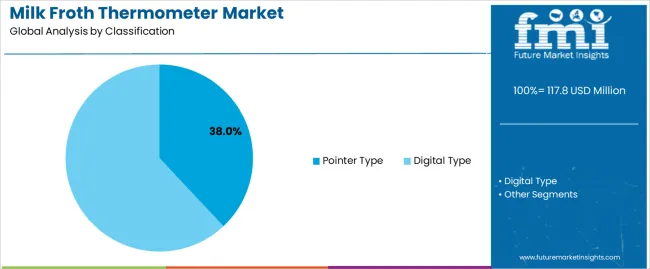
The pointer type segment accounts for approximately 38.0% of the global milk froth thermometer market in 2025, representing the leading classification category. Its position is supported by continued consumer preference for analog thermometers in household and small café applications, where simplicity and cost-effectiveness remain key purchasing factors. Pointer-type devices provide immediate temperature feedback and require no batteries or digital calibration, ensuring reliability and longevity in daily use.
The segment’s prominence is also attributed to its accuracy within the optimal frothing range of 55°C to 70°C, which is essential for maintaining milk texture and taste quality. Manufacturers focus on corrosion-resistant stainless-steel probes, improved dial visibility, and adjustable clips for ease of attachment to frothing pitchers. While digital thermometers offer enhanced precision and automatic alerts, the tactile and straightforward operation of analog models continues to appeal to home users and small-scale establishments. Demand is strongest in Europe and North America, where traditional barista techniques and manual espresso equipment maintain popularity. The pointer type segment remains the preferred choice for consumers seeking dependable, maintenance-free instruments aligned with everyday beverage preparation routines.
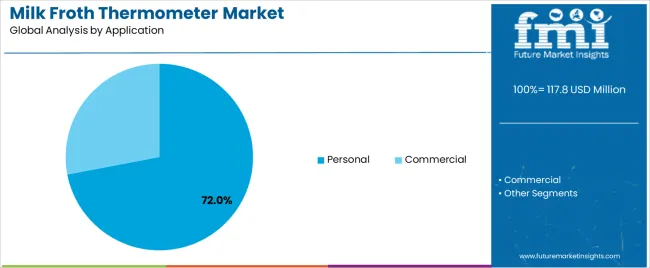
The personal use segment represents about 72.0% of the total milk froth thermometer market in 2025, making it the dominant application category. This leadership reflects increasing home consumption of specialty coffee and other milk-based beverages, which has encouraged consumers to adopt café-style tools for personal use. Milk froth thermometers enable precise control of frothing temperature, improving drink consistency and preventing overheating or texture loss.
The segment benefits from widespread adoption of home espresso machines and milk frothers, particularly in North America and East Asia, where premium coffee preparation at home continues to expand. Personal users favor thermometers that are compact, affordable, and easy to clean. Manufacturers have responded with ergonomic designs, integrated clips, and high-contrast dials suitable for domestic kitchens. Online retail platforms have also contributed to distribution growth by offering broad product accessibility and comparative pricing transparency. Although commercial applications are increasing in boutique cafés, household demand remains the core driver of overall market growth. The personal use segment’s strong market share demonstrates its alignment with lifestyle shifts toward home-based beverage customization and growing consumer familiarity with barista-style equipment in the global household appliance market.
The milk froth thermometer market is gaining momentum as specialty coffee culture spreads and both home baristas and commercial cafés seek precise tools for frothing milk and steam-texturing. Demand is driven by the rising popularity of craft drinks like lattes and cappuccinos, increasing installation of espresso machines and growing consumer willingness to invest in premium brewing accessories. Adoption is constrained by competition from integrated machine sensors, price sensitivity among casual users and the narrow application scope confined largely to coffee and milk-based beverages. Manufacturers are responding with digital models, smart connectivity and ergonomic designs to capture both home and professional segments.
The demand surge for milk frothing thermometers stems from the desire to match café-style texture and flavour at home or in commercial settings. As consumers adopt high-end espresso machines and coffee preparation becomes a visible part of the lifestyle, the need for accurate temperature control grows. For retail chain buyers or kitchen-equipment suppliers, a USP lies in "digital milk-frothing thermometers featuring rapid-response probes and preset temperature alerts with clip-on mounting for café jugs," which can enhance consistency, reduce over-scalding and support high-volume service. This positions thermometers as essential accessories rather than optional tools.
While the market shows promise, key restraints persist. Many entry-level home users may rely on integrated machine sensors or traditional manual frothing methods, reducing demand for standalone thermometers. Price sensitivity particularly among casual users limits uptake of high-precision digital models. In commercial kitchens, integration and cleaning demands add operational complexity. For thermometer suppliers, a relevant USP to address this is "cost-effective analog models with durable stainless-steel probe and jug-clip, offering acceptable accuracy for small cafés and budget-sensitive users," which helps lower the barrier to adoption in cost-conscious segments.
Major trends include the shift toward digital connectivity, multifunctionality and sustainable design. Manufacturers are introducing Bluetooth-enabled thermometers that sync with recipe apps, track frothing data and provide remote alerts. Compact, sleek probe designs and eco-friendly materials are becoming more common as home barista culture matures. For equipment specifiers, a strong USP is "smart milk-frothing thermometer platform with app integration, data logging and recipe library for training staff and maintaining consistency across café outlets." These innovations support both residential and professional market growth while aligning with digital kitchen trends.
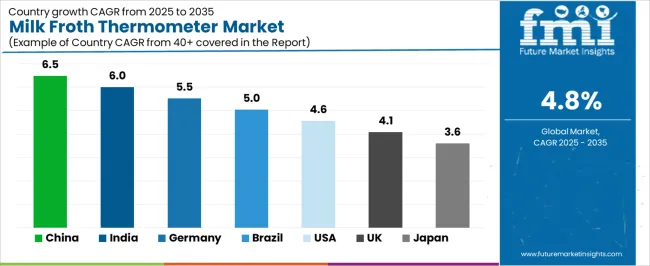
| Country | CAGR (%) |
|---|---|
| China | 6.5% |
| India | 6.0% |
| Germany | 5.5% |
| Brazil | 5.0% |
| USA | 4.6% |
| UK | 4.1% |
| Japan | 3.6% |
The milk froth thermometer market is expanding steadily across global regions, with China leading at a 6.5% CAGR through 2035, supported by the rapid growth of the café culture, commercial kitchen expansion, and increased production of coffee accessories. India follows at 6.0%, driven by rising café chains, home brewing adoption, and demand for affordable barista tools. Germany records 5.5%, leveraging precision manufacturing, material quality, and integration of digital thermometry in café equipment. Brazil grows at 5.0%, reflecting increasing coffee consumption and café franchise development. The USA, with a 4.6% CAGR, remains a mature market emphasizing innovation and professional-grade instruments, while the UK (4.1%) and Japan (3.6%) focus on premium kitchenware trends, ergonomic design, and expanding coffee culture in domestic markets.
China is observing strong expansion in the milk froth thermometer market, projected to grow at a CAGR of 6.5% through 2035. The rapid increase in café chains, specialty coffee shops, and domestic espresso machine usage is driving demand for precision thermometers. Local manufacturers are improving accuracy, temperature range, and build quality to serve both commercial and household markets. Rising consumer focus on beverage preparation standards supports steady product adoption. Export activity from Chinese suppliers is also expanding, enhancing global market reach.
India is witnessing consistent growth in the milk froth thermometer market, increasing at a CAGR of 6.0%, driven by rising café culture and urban coffee consumption. Local production of café tools and barista equipment is expanding through small-scale manufacturing clusters. The increasing number of specialty beverage outlets and hotel coffee services supports product diversification. Digital thermometers and durable stainless-steel designs are gaining traction across urban retail networks, aligning with the country’s expanding hospitality sector.

Across Germany, the milk froth thermometer market is advancing at a CAGR of 5.5%, supported by precision manufacturing and strong café industry standards. Producers emphasize stainless steel quality, fast temperature response, and calibration stability to meet barista-grade performance requirements. Integration of thermometers into espresso and frothing systems improves operational consistency across professional coffee machines. Rising popularity of artisanal coffee and home brewing continues to sustain steady demand for high-accuracy instruments.
Brazil is recording steady development in the milk froth thermometer market, projected to grow at a CAGR of 5.0% through 2035. Expansion in coffee retail and dairy-based beverage production supports increasing demand for temperature-control tools. Local suppliers are improving product materials, including corrosion-resistant steel and high-visibility dial displays. Growth in coffee festivals and training programs for baristas is encouraging consistent product utilization across commercial establishments.
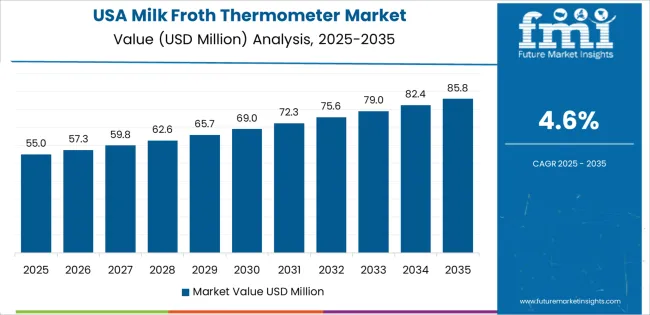
In the United States, the milk froth thermometer market is growing at a CAGR of 4.6%, supported by innovation in temperature sensing technologies and expanding specialty coffee markets. Manufacturers are introducing dual-scale thermometers with rapid response and anti-fog displays for professional and home users. Increasing penetration of coffee chains and craft cafés sustains equipment demand. Growth in smart home appliances integrating thermal monitoring functions is also contributing to evolving product applications.
Across the United Kingdom, the milk froth thermometer market is advancing at a CAGR of 4.1%, supported by widespread adoption of specialty coffee and increased barista training programs. Professional coffee equipment distributors are expanding product lines with precision thermometers catering to independent cafés. Sustainability trends are driving the use of recyclable materials in manufacturing. The country’s strong café culture and competitive retail environment continue to support regular equipment upgrades.
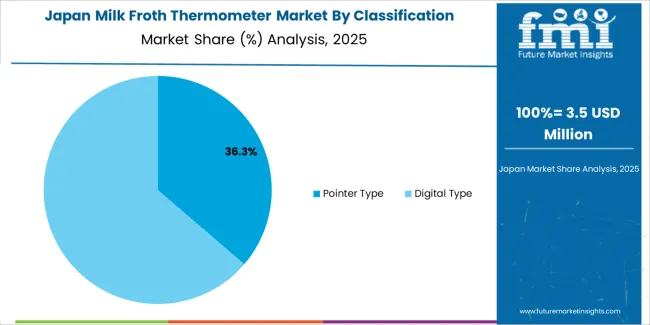
Japan is showing steady advancement in the milk froth thermometer market, forecast to grow at a CAGR of 3.6% through 2035. Domestic manufacturers emphasize compact design, thermal accuracy, and consistent calibration for high-performance applications in cafés and restaurants. Integration with automatic milk frothing systems is improving product compatibility. The country’s emphasis on craftsmanship and precision manufacturing ensures stable product demand across both professional and home users seeking quality assurance.

The global milk froth thermometer market is moderately fragmented, featuring established kitchenware brands and niche coffee equipment specialists. Beans leads the market through barista-grade thermometers designed for consistent frothing accuracy and fast temperature response. Taylor and CDN follow with strong distribution networks and product portfolios emphasizing reliability, ease of calibration, and durable stainless-steel construction.
Etekcity and Comark Instruments extend competitiveness through digital and infrared thermometer variants suited for both home and professional applications. BonJour and OXO focus on ergonomically designed thermometers integrated into premium coffee tool sets targeting home brewing enthusiasts. Brewista and Rattleware contribute to the professional segment by supplying precision instruments compatible with commercial espresso equipment and café environments.
Competition across this market is influenced by measurement precision, build quality, and ease of maintenance. Manufacturers differentiate through digital display integration, waterproof construction, and food-safe materials ensuring long-term durability. Price segmentation reflects the growing divide between mass-market kitchen tools and barista-grade specialty instruments. Strategic differentiation depends on response speed, calibration consistency, and adaptability across frothing vessels. As specialty coffee consumption expands globally, demand for precision thermometers supporting consistent milk texturing continues to rise. Long-term competitiveness will hinge on material sustainability, digital connectivity innovations, and temperature accuracy optimization aligned with evolving café workflow and home brewing preferences.
| Items | Values |
|---|---|
| Quantitative Units (2025) | USD million |
| Type (Classification) | Pointer Type, Digital Type |
| Application | Personal, Commercial |
| Regions Covered | North America, Europe, East Asia, South Asia, Latin America, Middle East & Africa, Eastern Europe |
| Countries Covered | China, India, USA, Germany, Brazil, UK, Japan, and 40+ countries |
| Key Companies Profiled | Beans, Taylor, CDN, Etekcity, Comark Instruments, BonJour, OXO, Brewista, Rattleware |
| Additional Attributes | Dollar sales by classification and application segments; regional adoption trends in home and café markets; competitive landscape featuring analog and digital thermometer manufacturers. |
The global milk froth thermometer market is estimated to be valued at USD 117.8 million in 2025.
The market size for the milk froth thermometer market is projected to reach USD 188.3 million by 2035.
The milk froth thermometer market is expected to grow at a 4.8% CAGR between 2025 and 2035.
The key product types in milk froth thermometer market are pointer type and digital type.
In terms of application, personal segment to command 72.0% share in the milk froth thermometer market in 2025.






Our Research Products

The "Full Research Suite" delivers actionable market intel, deep dives on markets or technologies, so clients act faster, cut risk, and unlock growth.

The Leaderboard benchmarks and ranks top vendors, classifying them as Established Leaders, Leading Challengers, or Disruptors & Challengers.

Locates where complements amplify value and substitutes erode it, forecasting net impact by horizon

We deliver granular, decision-grade intel: market sizing, 5-year forecasts, pricing, adoption, usage, revenue, and operational KPIs—plus competitor tracking, regulation, and value chains—across 60 countries broadly.

Spot the shifts before they hit your P&L. We track inflection points, adoption curves, pricing moves, and ecosystem plays to show where demand is heading, why it is changing, and what to do next across high-growth markets and disruptive tech

Real-time reads of user behavior. We track shifting priorities, perceptions of today’s and next-gen services, and provider experience, then pace how fast tech moves from trial to adoption, blending buyer, consumer, and channel inputs with social signals (#WhySwitch, #UX).

Partner with our analyst team to build a custom report designed around your business priorities. From analysing market trends to assessing competitors or crafting bespoke datasets, we tailor insights to your needs.
Supplier Intelligence
Discovery & Profiling
Capacity & Footprint
Performance & Risk
Compliance & Governance
Commercial Readiness
Who Supplies Whom
Scorecards & Shortlists
Playbooks & Docs
Category Intelligence
Definition & Scope
Demand & Use Cases
Cost Drivers
Market Structure
Supply Chain Map
Trade & Policy
Operating Norms
Deliverables
Buyer Intelligence
Account Basics
Spend & Scope
Procurement Model
Vendor Requirements
Terms & Policies
Entry Strategy
Pain Points & Triggers
Outputs
Pricing Analysis
Benchmarks
Trends
Should-Cost
Indexation
Landed Cost
Commercial Terms
Deliverables
Brand Analysis
Positioning & Value Prop
Share & Presence
Customer Evidence
Go-to-Market
Digital & Reputation
Compliance & Trust
KPIs & Gaps
Outputs
Full Research Suite comprises of:
Market outlook & trends analysis
Interviews & case studies
Strategic recommendations
Vendor profiles & capabilities analysis
5-year forecasts
8 regions and 60+ country-level data splits
Market segment data splits
12 months of continuous data updates
DELIVERED AS:
PDF EXCEL ONLINE
Milk Carton Market Size and Share Forecast Outlook 2025 to 2035
Milking Automation Market Size and Share Forecast Outlook 2025 to 2035
Milking Robots Market Size and Share Forecast Outlook 2025 to 2035
Milk Packaging Market Size and Share Forecast Outlook 2025 to 2035
Milk Clarifier Market Size and Share Forecast Outlook 2025 to 2035
Milk Homogenizer Machine Market Size and Share Forecast Outlook 2025 to 2035
Milk Pasteurization Machines Market Size and Share Forecast Outlook 2025 to 2035
Milk Sterilizer Machine Market Size and Share Forecast Outlook 2025 to 2035
Milk Powder Packaging Market Size and Share Forecast Outlook 2025 to 2035
Milk Powder Packaging Machines Market Size and Share Forecast Outlook 2025 to 2035
Milk Protein Market - Size, Share, and Forecast 2025 to 2035
Milk Ingredients Market Analysis - Size, Share, and Forecast Outlook 2025 to 2035
Milk Mineral Concentrate Market Trends-Demand, Innovations & Forecast 2025 to 2035
Milk Thistle Market Analysis by Form, Distribution Channel and Region through 2035
Milk Powder Market Analysis by Type, Distribution Channel, Region and Other Applications Through 2035
Milk Tank Cooling System Market Growth – Trends & Forecast 2025 to 2035
Milk Alternatives Market – Growth, Demand & Dairy-Free Trends
Milk Protein Hydrolysate Market Growth - Infant Nutrition & Functional Use 2024 to 2034
Milking Equipment Market
Milk Bottle Market Trends & Industry Growth Forecast 2024-2034

Thank you!
You will receive an email from our Business Development Manager. Please be sure to check your SPAM/JUNK folder too.
Chat With
MaRIA